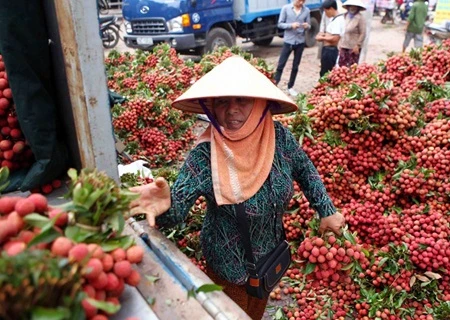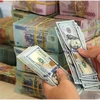HCM City (VNA) – Fruit and vegetable exports are likely to achieve the Government's target of 1.65 billion USD this year, according to the Ministry of Industry and Trade.
More and more countries have opened their door to Vietnamese fruits and vegetables, including selective markets like the US, Australia, the EU and Japan.
Earnings from fruit and vegetable exports have increased strongly in recent years, from 460 million USD in 2010 to 1.47 billion USD last year, according to the Vietnam Fruit and Vegetable Association (Vinafruit).
The figure topped 1.342 billion USD in the first nine months of this year, a surge of more than 116 percent over the same period last year.
Vietnam exports 40 kinds of fruits and vegetables to 40 countries and territories, including major export markets like China, Japan, the Republic of Korea, the US, Malaysia and Thailand.
Last year, more than 1.6 million tonnes of fruits and vegetables were exported, of which dragonfruit accounted for more than 997,000 tonnes, watermelon nearly 300,000 tonnes, longan more than 100,000 tonnes, litchi over 70,000 tonnes and rambutan 600 tonnes.
Exports of fresh fruit to demanding markets like the US last year went up by 1.5 times over 2013, with more than 3,000 tonnes of fresh fruits exported.
China is the largest importer of fruits and vegetables from Vietnam, reaching more than 435 million USD last year, accounting for 29 percent of the total exports, according to Vinafruit.
China remained the largest importer in the first eight months of this year with 784.05 million USD worth of imports, a surge of 139 percent compared to the corresponding period last year, accounting for 64.2 percent of Vietnam's total fruits and vegetables exports.
Major exports to China include mango, banana, dragonfruit and rambutan.
The second largest importer of fruits and vegetables from Vietnam is Japan with 49.8 million USD in the period, accounting for 4.1 percent of Vietnam's total exports, a rise of 1.3 percent over the same period last year.
The third position is the Republic of Korea with total imports of 47.59 million in the period, an increase of 22 percent compared to the same period last year, accounting for 3.9 percent of Vietnam's total exports.
Exports of fruits and vegetables to Cambodia were only 4.78 million USD in the period, but it represented an increase of 215.7 percent compared to the same period last year.
The increase in exports of fruits and vegetables is mainly due to a larger area of fruit and vegetable cultivation that meets VietGap standards, which helped increase the quality of materials.
In September, more than 20 hectares of big longan cultivated in the northern province of Hung Yen met VietGap standards and are now eligible for export to the US, according to the Ministry of Agriculture and Rural Development.
Vietnam started to export dragonfruit to the US market in 2008, with only 100 tonnes that year.
The export volume has steadily increased, reaching 1,500 tonnes last year and 1,152 tonnes in the first seven months of this year.
Rambutan exports to the market have also increased strongly since late 2011.
Last year, the US market began to accept Vietnamese longan and litchi. Starfruit and mango are both also expected to be shipped to the US by the end of this year.
New Zealand and Australia this year also allowed the import of Vietnamese rambutan and litchi, respectively, and Japan has just opened its market for Vietnamese fresh mango.
At the same time, imports of fruits and vegetables to Vietnam also rose in the first nine months of the year.
Nguyen Van Ky, General Secretary of Vinafruit, said imports of fruits and vegetables were 460 million USD in the first nine months, or 114.3 percent over the same period last year (403 million USD).
Major exporters of fruits and vegetables of Vietnam include Thailand, China and the US.-VNA
























